In Michigan, there are around 500 different spider species, and the United States has more than 3,000 spiders to appreciate. Spiders are one of the most feared animals in the world, and most species are harmless and very beneficial to their environments. This article will cover 8 brown spiders in Michigan and some interesting things we can learn about them.
Michigan is home to various habitats perfect for spiders, and many of them have brown coloring. The brown recluse is among the most feared of all brown spiders, with people often confusing other species for them. Nearly all spiders can produce venom; most are not medically significant to humans.
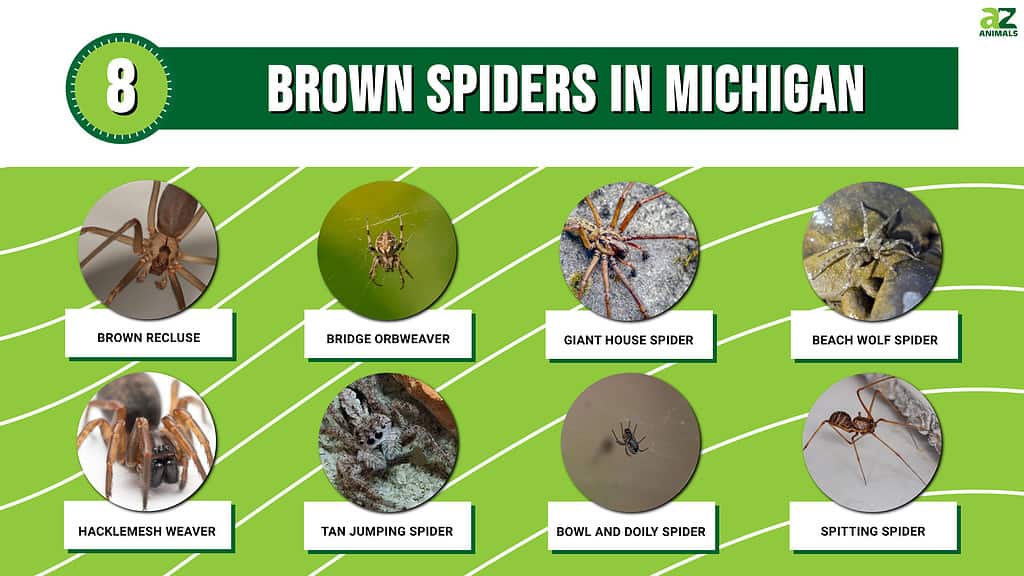
Here are 8 brown spiders in Michigan and the interesting things you should know about each.
1. Brown Recluse

The brown recluse spider is active at night and spends this period hunting small insects.
©Nick626/Shutterstock.com
The brown recluse is one of Michigan’s most dangerous and feared spiders, and other species are regularly confused for this species. The brown recluse’s most identifiable trait is the dark violin-shaped marking found on its cephalothorax. The brown recluse has a dusty sand coloring, thin legs, and no other markings on its body.
It is extremely common for the brown recluse to make their way into homes, but in Michigan, sightings are rare, as they inhabit regions far from residential areas. This spider is commonly found under debris like rock or logs, preferring to live in humid and dark areas. They are active at night and spend this period hunting small insects.
The venom of the brown recluse is necrotic, causing damage to the bitten area.
Some of the symptoms from their bite include:
- Redness
- Swelling
- Muscle Aches
- Dizziness
- Bruising
Bites may occur if you provoke the spider, but death from this species is still extremely rare. The brown recluse is one of the most well-known brown spiders but is regularly confused with other species.
2. Bridge Orbweaver

Bridge orb weavers are sexually dimorphic.
©Paul Reeves Photography/Shutterstock.com
The great lakes in Michigan provide the perfect habitat for the bridge orb weaver and other spiders that prefer to live in moist, vegetated areas. Like other orb-weaver species, this spider creates circular webs to live in. The bridge orb-weaver often makes its web on structures like bridges, porches, and the sides of houses. This spider is often found in well-lit areas near a body of water since insects are more common in those parts.
Bridge orb weavers’ colors range from brown to grayish brown, and they have a mottled pattern covering their bodies and dark bands over their legs. Like other members of the orb-weaver family, this species is sexually dimorphic. Females have larger bulbous abdomens with spindly legs, and males have a much sleeker body, long legs, and pedipalps.
3. Giant House Spider
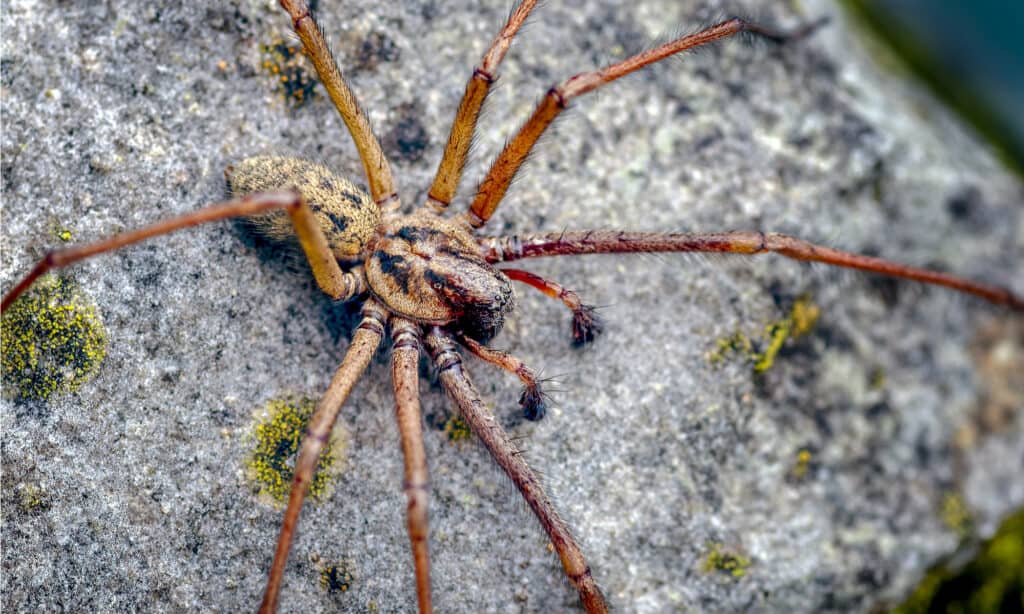
The giant house spider is one of the largest you can find in your home and creates messy webs to live in.
©R K Hill/Shutterstock.com
The giant house spider is one of the largest spiders you can find in Michigan and is painted in dark brown coloring. This spider has a mottled pattern of yellow markings on its abdomen. The legs of this species are large and thin and are this spider’s largest feature. This species is one of the largest you can find in your home and creates messy webs to live in.
The webs of this spider are made in dark, secluded areas, near crevices for them to hide. In their webbing is a funnel-shaped area for them to retreat to. They feed on prey that fall into their webs, quickly lunging at them from their funnel retreat. This spider is rarely seen since it spends its life hidden in crevices. Males are seen in the months of summer, spending their time looking for a mate.
4. Beach Wolf Spider
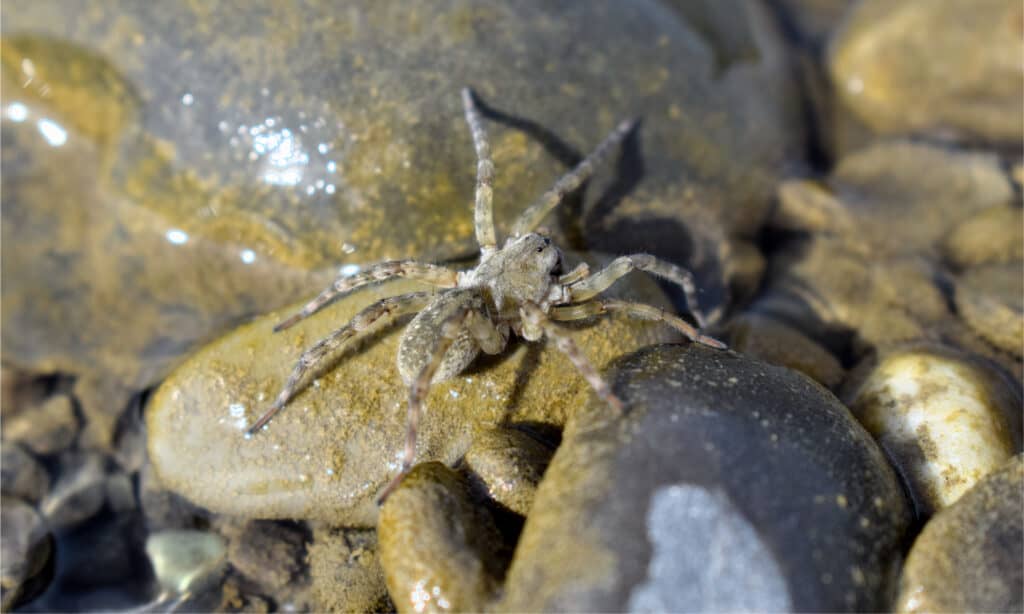
Wolf spiders get their name from their fierce hunting ability, feeding on insects and other small animals like frogs.
©Simone Morris/Shutterstock.com
Beach wolf spiders are members of the Lycosidae family found in Michigan and other parts of North America. This spider is common in sandy habitats like deserts or beaches and lives in various other habitats like forests and grasslands. The beach wolf spider is one of the largest species in Michigan. It has light to dark brown coloring, a mottled pattern covering them, and small bands on its legs.
Beach wolf spiders are not seen often since their color makes it easy for them to camouflage in sandy or dirt areas. They are active at night, and during this spider hides under debris like driftwood or large rocks. Wolf spiders get their name from their fierce hunting ability, feeding on insects and other small animals like frogs.
Able to move very quickly, beach wolf spiders ambush their prey and kill them with their venom. This spider is not aggressive and will try to flee if approached. Occasionally this species may make its way into homes looking for food. In the late summer and fall months, wolf spiders carry their young on their backs until the spiderlings can fend for themselves.
5. Hacklemesh Weaver

The hacklemesh weaver’s web is messy and made with frilled wooly silk.
©Eric Isselee/Shutterstock.com
Found across the United States, the hacklemesh weaver is a brown spider regularly confused with the brown recluse. This species ranges from light to dark brown, with some having reddish-brown coloring. They have a mottled pattern covering their body and dark bands on their legs.
The web this species makes is messy, with a retreat similar to that of a funnel spider. They prefer to live in dark and damp places, spending most of their life hidden in a crevice. The bite from the hacklemesh weaver is not dangerous but can be painful due to their large fangs. The web of the hacklemesh weaver is messy and for catching small insects. The legs of this spider are long and make it easy for them to travel over their sticky silk to feed on prey.
6. Tan Jumping Spider
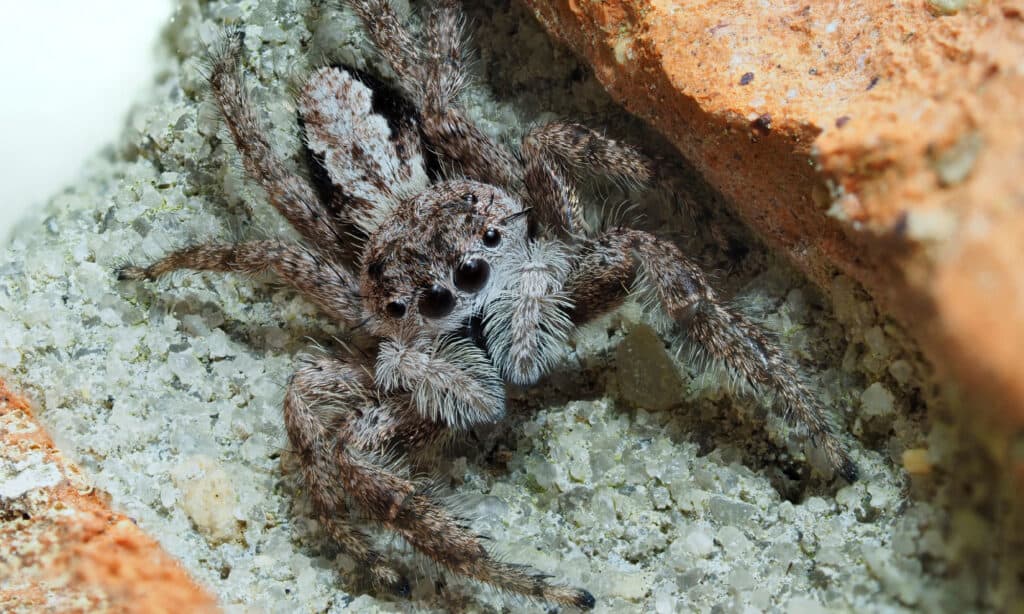
The tan jumping spider has keen eyesight and excellent jumping ability.
©iStock.com/sdbower
Named for its brown coloring, the tan jumping spider is a very common species in Michigan. This spider has a mottled pattern of brown, black, and gray, making it easy for them to camouflage into wooded habitats. Tan jumping spiders spend their time on vertical surfaces like trees, large plants, and the sides of houses. This spider is hairy, looking almost like a teddy bear. Active during the day, this spider spends its time hunting for small insects.
Tan jumping spiders, like other Salticidae, have amazing eyesight that they use to hunt. Able to leap up to 5 times its body length, this species uses these traits to hunt small insects like aphids, flies, and other spiders. Jumping spiders have two large eyes giving them binocular vision, with smaller ones surrounding their head like a crown. The location and size of the eyes let them monitor their surroundings, having close to a full 360 degrees of vision.
7. Bowl and Doily Spider

The bowl and doily spider gets its name from its uniquely shaped web.
©iStock.com/ErikAgar
The bowl and doily spider is a common brown spider found in Michigan. This species inhabits woodland and forested habitats and is easily identifiable by the unique webs they create. Two sections of this spider’s web exist. The top of this spider’s webs is flat and shaped like a doily. The doily webbing is above the bowl and is used to push spiders further into the bow trap.
This species sits on the bowl section of its web and waits for prey to fall into its silk. Small insects like flies and gnats are what this spider feeds on, and they will pull their prey into their web and inject them with venom. The bowl section of this spider’s web is useful in giving the spider a safe place to hunt its prey.
A very small spider, this species’ color ranges from tan to reddish-brown, and white markings may appear on its body. The webs this spider creates are their most identifiable trait, and vegetation like bushes and shrubs is what supports their web. It is not uncommon for this species to live with others in a large communal web.
8. Spitting Spider
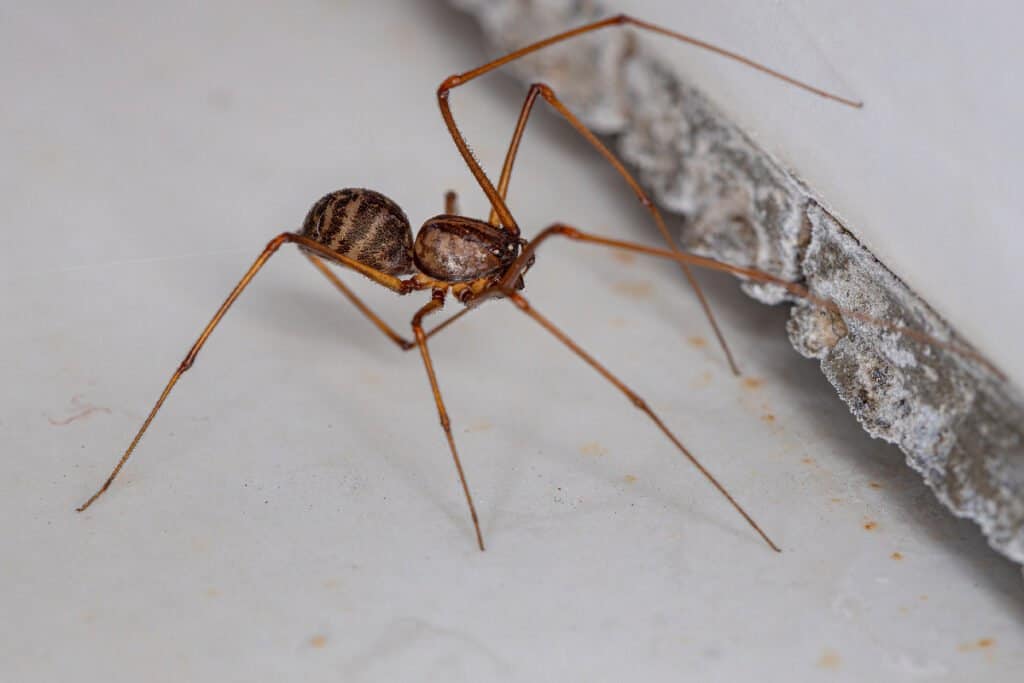
The brown spitting spider catches prey with venomous silk that it shoots from its abdomen.
©iStock.com/ViniSouza128
Spitting spiders inhabit many regions within the eastern United States, like Michigan, but they also have a population in some European countries. This spider lives in forest habitats and is one of the only spiders in its region that spits silk to take down their prey. Spitting spiders have tan coloring, with dark blotches covering their body. Their legs are long and thin, with dark bands covering them. Unlike other species, this spider only has six eyes.
The front legs of this species are long, and the spider uses them to aim at the prey they are hunting. The substance the spider spits is a mix of venom and liquified silk. Able to successfully neutralize prey up to .75 inches away and spit up to 28 meters per second.
A nocturnal species, they spend their time feeding on small insects. The sticky substance they spit quickly takes down prey and allows the spider to inject its prey with venom. Occasionally found in homes, this spider is harmless to humans.
Summary of 8 Brown Spiders in Michigan
| Number | Spider |
|---|---|
| 1 | Brown Recluse |
| 2 | Bridge Orbweaver |
| 3 | Giant House Spider |
| 4 | Beach Wolf Spider |
| 5 | Hacklemesh Weaver |
| 6 | Tan Jumping Spider |
| 7 | Bowl and Doily Spider |
| 8 | Spitting Spider |
The photo featured at the top of this post is © Aaron Carlson / CC BY-SA 2.0, Flickr – License / Original
Thank you for reading! Have some feedback for us? Contact the AZ Animals editorial team.






